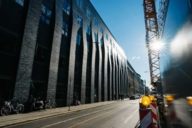
The TU München (TUM) is one of the best technical universities in Europe. Ever since it was founded in 1868, it has focused on the great challenges of the future, describing itself as a driver of change in German higher education policy.
The TUM has undergone a remarkable development. The number of students has steadily increased to around 40,000 (as of 2019). In 2006, the university became one of the top three German elite universities within the Excellence Initiative. It defended its title in 2012 and has long been regarded as one of Europe’s best research universities.
It’s no coincidence that the TUM has produced so many important scientists, architects, engineers and entrepreneurs, including Karl Max von Bauernfeind, Rudolf Diesel, Claude Dornier and Carl von Linde. It all started with new scientific discoveries and the advancement of technology in the 19th century. This laid the foundations for the academic teaching of engineering. There was clearly a need for a “university of all technical studies”, but this role was initially assigned to the long-established Ludwig-Maximilians-Universität (Ludwig Maximilian University, LMU).
But King Ludwig II recognised the signs of the times and founded the newly structured “Polytechnische Schule München” (Munich Polytechnic) as a university institution in 1868. It became officially known as the “Technische Hochschule München” (TH) in the 1877/78 academic year and quickly moved into the new building designed by Gottfried von Neureuther on Arcisstrasse.
The former “TH München” became authorised to issue doctorates in 1901, and women began to study there in 1906. During this period, the university temporarily overtook the TH Berlin as the largest technical university in Germany.
An increasing amount of subjects were added in the years that followed, and the university took over other smaller institutions like the “Handelshochschule München” (Munich School of Commerce) and the “Hochschule für Landwirtschaft und Brauerei” (School of Agriculture and Brewery) in Weihenstephan. The university had five faculties in 1940: General Sciences, Civil Engineering, Mechanical Engineering, Agriculture and Brewery. But things weren’t going to stay that way forever … There are now over ten faculties like Computer Science, Sports Science, Architecture and Environmental Engineering, as well as a research reactor for physics and lots more at four locations in Munich, Garching, Freising-Weihenstephan and Straubing.
And lots of things are still happening today. New research centres and institutes are emerging. It’s been known as the “Technical University of Munich” since 1970 and is now boosting its cooperation with partners from industry and society, giving students good chances on the labour market. And the university is becoming increasingly international. A growing amount of degree programmes are offered in English. The TUM even launched its expansion abroad in 2002 by opening a campus in Singapore. This was followed by locations in Beijing, Cairo and Sao Paulo.
It’s also interesting to note that the TUM is now moving away from purely technical subjects to the fields of social sciences and economics, offering degree programmes like Business Administration with a focus on technology and Life Science Economics and Policy. The Munich Centre for Technology in Society was established in 2012, offering degree programmes that focus on the social importance of modern technology. The TUM recently took over the School of Politics at the Ludwig Maximilian University. This clearly highlights its intention to focus more on the humanities.